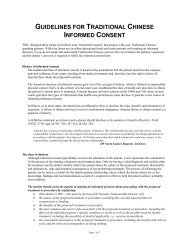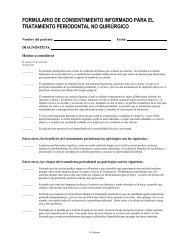dentistpatient
guidelines for informed consent - The Dentists Insurance Company
guidelines for informed consent - The Dentists Insurance Company
You also want an ePaper? Increase the reach of your titles
YUMPU automatically turns print PDFs into web optimized ePapers that Google loves.
GUIDELINES FOR INFORMED CONSENTHistory of informed consentThe modern doctrine of informed consent is based on the assumption that the patient must bear theexpense, pain and suffering of any injury resulting from medical treatment and, therefore, has theright to know all material facts about the proposed treatment.The American doctrine of informed consent grew out of the concept of battery, which is defined asunpermitted physical contact. Early in this century several court cases established the duty of healthcare providers to obtain the patient’s consent prior to treatment. Consent became informed consent inthe 1950s and ’60s when several courts specified the types of information that health carepractitioners must disclose to patients in the course of obtaining informed consent.The duty to discloseAlthough informed consent specifically involves the education of the patient, it also represents theculmination of the process of developing a diagnosis and treatment plan. Only by having a soliddiagnosis and realistic plan for treatment can the dentist reliably inform the patient about the nature ofthe proposed treatment, the benefits and alternatives, risks and potential consequences of notperforming treatment. The process of informing the patient can be seen as a model for the <strong>dentistpatient</strong>relationship, one in which the dentist shares his or her knowledge, findings andrecommendations as part of a cooperative effort to help the patient achieve a healthy oral condition.The dentist must assist the patient in making an informed decision about proceeding with theproposed treatment or procedure by explaining:• the nature of the proposed treatment or procedure, including the cost and expected time forrecuperation or healing.• the benefits of the proposed treatment or procedure.• the most common and reasonably likely risks associated with the proposed treatment orprocedure, including the effect of the individual patient’s specific condition or needs as well asthe possible need for further treatment, including the possibility of death if applicable, i.e.,reaction to anesthesia.• any reasonable alternatives to the proposed treatment or procedure, including the benefits andrisks of each, and the risks and consequences of doing nothing.Informed refusalIf the patient refuses the proposed treatment or procedure, the dentist must inform the patientabout the likely consequences and obtain the patient’s informed refusal.Merely obtaining a patient’s informed refusal does not relieve the dentist from practicing within thestandard of care. Even if the dentist fully discloses the potential consequences of refusal and thediscussion has been documented properly, a patient may not consent to substandard care nor may thedentist ethically or legally agree to provide it. Particularly in the case of refused x-rays, the patient’sdecision may effectively prevent the dentist from providing further treatment. This fact should beaddressed during the informed refusal discussion.Page 1 of 3
Exceptions to disclosureThe dentist has no duty to disclose where:• the patient asks not to be advised.• the procedure is simple and any danger is remote and commonly understood to be remote. Forexample, the risk of death by anaphylactic reaction following an injection is a remote risk oftreatment.• the risk is minor and seldom results in serious side effects. For example, gingival discomfortwhile biting down on bitewing x-ray films is a minor risk of treatment.• disclosure would so seriously upset the patient that he or she would be unable to rationallyweigh the risks of refusing the procedure (known as the therapeutic exception).In addition to these exceptions, informed consent is not required in very rare instances where the needto respond immediately to an unanticipated condition or a life-threatening emergency makes itimpossible to obtain the patient’s informed consent. However, since dental emergencies, unlikemedical emergencies, are rarely life-threatening, the dentist should make every reasonable effort toobtain the patient’s informed consent or refusal.The informed consent discussionThe dentist should obtain the patient’s informed consent through a face-to-face discussion thatallows the patient sufficient time to make an informed decision. The discussion should beappropriate to the patient’s level of understanding.Ideally, the informed consent discussion should take place at least several days before treatment, suchas when the dentist presents the treatment plan (this is particularly important for extensive, complexor risky treatment). Since the dentist is legally obligated to disclose information in a manner thepatient can understand, the discussion should involve lay terminology, not scientific jargon. For thesame reason, consider providing translated informed consent materials and, if necessary, aninterpreter for non-English-speaking patients who may require it. The dentist must decide what to tellthe patient about a procedure based on whether the patient has undergone the same or similarprocedure previously. The use of educational materials is recommended.Because the dentist bears the ultimate legal and ethical responsibility for informing the patient, theinformed consent discussion cannot be delegated to staff. Although staff can assist by presenting thepatient with printed or audiovisual materials, the dentist should personally solicit and address thepatient’s questions and concerns.Informed consent for minor patientsFor minor patients, obtain the informed consent of the parent, custodial parent or legal guardian.Where parents live separately, the patient’s personal information form should indicate which parent isthe custodial parent. Where separated parents share custody, the patient’s record should containletters from each providing consent and authorization to treat. Asking for a parent’s or custodialparent’s blanket consent for emergency treatment in advance of an emergency is one useful way toavoid confusion and delays should the patient require emergency care when a parent or legal guardianis not present.Page 2 of 3
Documenting informed consentThe patient’s treatment record should document the informed consent discussion and the patient’sdecision, including informed refusal.Nothing in New Jersey law specifies a means for documenting the informed consent discussion. Atminimum, the patient record should document the fact that the patient received information aboutrisks, benefits and alternatives and consented to or refused the proposed treatment or procedure.Where the proposed treatment or procedure is extensive, invasive or risky, a written informed consentform is recommended for facilitating and documenting the discussion.Content of informed consent formsForms for many procedures are available through professional liability insurers, commercial vendorsand dental specialty organizations. Many dentists customize purchased forms or develop their ownforms. In either case, adequate forms should address the nature of the proposed treatment, benefitsand alternatives, risks and the potential consequences of not performing treatment, as well as enablethe dentist to include information specific to the case at hand. The form should be signed by thepatient, the dentist and a witness. The patient should receive a copy of the form and the originalshould be kept in the patient’s chart.Summary• Obtaining informed consent involves providing the patient with information about the nature ofthe proposed treatment, the benefits and alternatives of the proposed treatment, the risks oftreatment, as well as any other information specific to the patient’s unique condition. Patientswho refuse treatment must be informed of the potential consequences of their decision.• Informed consent is a process, not a form. It involves a face-to-face discussion between thedentist and patient, conducted with sufficient time to address all of the patient’s questions andconcerns. The task of obtaining a patient’s informed consent cannot be delegated to staff.• The informed consent discussion should be documented in the patient record, although the lawdoes not specify the means. Informed consent forms can be useful for helping the patient retaininformation, as well as for guiding and documenting the informed consent discussion.• The informed consent discussion, even if properly conducted and documented, does notabsolutely insulate the dentist from an allegation of negligence or lack of informed consent.However, being able to supply documentation of the discussion often dissuades patients frompursuing a complaint. In all cases, thorough documentation greatly increases the dentist’schance of successfully defending against such allegations.For more informationFor more information about informed consent call 800.733.0634 or fax your request to 916.498.6175.Page 3 of 3Guidelines NJ



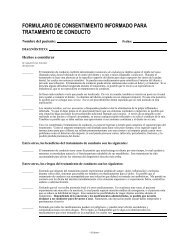
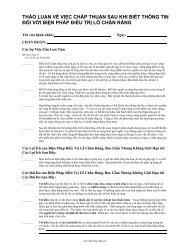
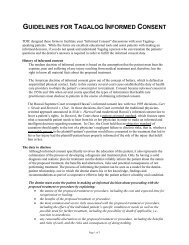



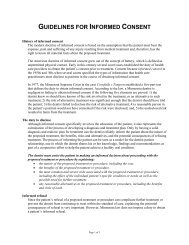


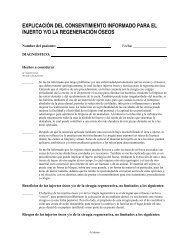
![치아 미백(표백)[TOOTH WHITENING (BLEACHING)]에 대한 정보 동의서](https://img.yumpu.com/52851055/1/190x245/-tooth-whitening-bleaching-.jpg?quality=85)
